It is said that the Eunectes murinus — referred to by laymen as the anaconda or the water boa — spends most of its time shooting its slimy body beneath the water, waiting for a hapless gazelle to stop and take a drink, only to grab the lithe animal with its jaws, coil its scaly muscular husk around its quivering body, squeezing and constricting until the animal is helpless (the animal is never crushed), where it then feasts upon the meat. It does this, because, while the boa does surface on land from time to time, the boa is more taken with the scummy agua. It does not know any better.
And while most mainstream newspaper book sections are devoted to thought over carnivorous instinct, there remain some critics, terrified of inhabiting any topography foreign to their hermetic environments and who remain needlessly hostile to any author crossing multiple ecosystems.
 The author in question is William T. Vollmann. And the book is Riding Toward Everywhere, a surprisingly thin volume (by Vollmann standards, at least) that concerns itself with trainhopping and vagrants. (Full disclosure: While the book isn’t Vollmann’s greatest, I did enjoy the book. And while I may be a devotee to Vollmann’s work, I have never let my admiration for the man hinder fair and critical judgment. Above all, I recognize that Vollmann, like any original and idiosyncratic author, must be read on his own terms. This would seem self-evident to even the most elementary reader, because of Vollmann’s style and his distinct subject matter. But other individuals, as I shall soon demonstrate, don’t share this commitment to due consideration.)
The author in question is William T. Vollmann. And the book is Riding Toward Everywhere, a surprisingly thin volume (by Vollmann standards, at least) that concerns itself with trainhopping and vagrants. (Full disclosure: While the book isn’t Vollmann’s greatest, I did enjoy the book. And while I may be a devotee to Vollmann’s work, I have never let my admiration for the man hinder fair and critical judgment. Above all, I recognize that Vollmann, like any original and idiosyncratic author, must be read on his own terms. This would seem self-evident to even the most elementary reader, because of Vollmann’s style and his distinct subject matter. But other individuals, as I shall soon demonstrate, don’t share this commitment to due consideration.)
A number of recent reviews reveal an astonishing paucity of insight and, in some cases, remarkable deficiencies in reading comprehension. And this all has me greatly concerned about the state of contemporary criticism. While there were dismissals from the Pittsburgh Post Gazette‘s Bob Hoover and the Los Angeles Times‘s Marc Weingarten that had the good sense to avoid dwelling so heavily on Vollmann’s peccadilloes, the majority of these negative reviews not only failed to comprehend Vollmann’s book, but appeared predetermined to despise it from the onset. They wished to judge Vollmann the man instead of Vollmann the author. Which is a bit like judging Dostoevsky not on his literary genius, but on his abject personal foibles. Or dismissing Woody Allen’s great films because he married his adopted daughter. This is the stance of blackguards who peddle in gossip, not criticism.
And yet speculation into Vollmann’s character was unfurled in messy dollops under the guise of “criticism” or “book reviewing.”
From Rene Denfeld’s review in The Oregonian:
There is a saying among some bloggers: “I think I just vomited a little in my mouth.”
That’s how I felt reading “Riding Toward Everywhere.”
William T. Vollmann is a mystifyingly respected writer, a man who has made his reputation by exploiting sex workers, the poor and other helpless targets as he plumbs their depths with his supposedly insightful pen, not to mention other appendages.
Well, this blogger has never typed that hackneyed sentence, in large part because resorting to cliches are about as enticing as four hours with a dentist (or, for that matter, dwelling on an essay written by a lazy writer). But then Ms. Denfeld has no problem letting false and near libelous conjecture get in the way of understanding what’s in the text. She fails to cite any specific examples on how Vollmann has “exploited” his subjects. And she has deliberately misread Riding Toward Everywhere to suit her false and incorrigible conclusions. To be clear on this, it was not — as Ms. Denfeld suggests — Vollmann who referred to “citizens” contemptuously, but the vagrants who Vollmann interviewed. Since Ms. Denfeld doesn’t appear to know how to read and infer from a book, here is the specific manner in which Vollmann establishes a “citizen.” Vollmann starts talking to vagrants in search of the notorious gang, the Freight Train Riders of America. Early on in the book, Vollmann approaches a man with a bandana and bluntly asks him, “Are you FTRA?”
You goddamned dufus! shouted the man. That’s the stupidest fucking thing I ever heard. You wanna commit suicide or what? I’m not even FTRA and you’re already starting to piss me off. Don’t you get it? We hate you.
Why’s that?
Because you’re just a goddamned citizen.
Sorry about that, I said. (33)
Denfeld further claims that Vollmann “fancies himself the Jack Kerouac of our times,” but it’s quite evident that Vollmann, in addition to pointing out the differences between hitting the roads and riding the rails, views himself as a somewhat clumsy traveler and does not permit his literary antecedents to define him:
Neither the ecstatic openness of Kerouac’s road voyagers, nor the dogged cat-and-mouse triumphs of London’s freight-jumpers, and certainly not the canny navigations of Twain’s riverboat youth define me. I go my own bumbling way, either alone or in company, beset by lapses in my bravery, energy, and charity, knowing not precisely where to go until I am there. (73)
Denfeld also writes, “His concession to the law is to borrow friends’ cars when he picks up hookers so if he gets caught, it won’t be his license that is lost.”
Again, Denfeld deliberately twists Vollmann’s words around. Here is what Vollmann actually wrote:
My city passes an ordinance to confiscate the cars of men who pick up prostitutes. This compels me to walk….It may well be that I am a sullen and truculent citizen; possibly I should play the game a trifle. But I do, I do: When I pick up prostitutes I use somebody else’s car. (4-5)
 It is clear here that Vollmann is being as straightforward as he can about his life, trying to set down personal fallacies he may have in common with his subjects. It would be one thing if Ms. Denfeld stated the precise problems she had with the book, but she remains so fixated in her happy little universe — which involves living with her partner with three adopted children and OMG! “teaching writing in low-income schools and volunteering in adoption education and outreach”; could it be that Vollmann is not the only “rich” person who “brags” about philanthropy? — that she can’t seem to consider that other people relate to the world a bit differently. And it’s clear that she can’t be bothered to engage with the issues that the book presents. Masticating upon this book, good or bad, seems beneath Ms. Denfeld’s abilities. Beyond Ms. Denfeld’s consistent failure at basic reading comprehension, I likewise remain gobsmacked that these flagrant errors, easily confirmed by checking Ms. Denfeld’s statements against the text (which runs a svelte 186 pages), were allowed to run in a major newspaper.
It is clear here that Vollmann is being as straightforward as he can about his life, trying to set down personal fallacies he may have in common with his subjects. It would be one thing if Ms. Denfeld stated the precise problems she had with the book, but she remains so fixated in her happy little universe — which involves living with her partner with three adopted children and OMG! “teaching writing in low-income schools and volunteering in adoption education and outreach”; could it be that Vollmann is not the only “rich” person who “brags” about philanthropy? — that she can’t seem to consider that other people relate to the world a bit differently. And it’s clear that she can’t be bothered to engage with the issues that the book presents. Masticating upon this book, good or bad, seems beneath Ms. Denfeld’s abilities. Beyond Ms. Denfeld’s consistent failure at basic reading comprehension, I likewise remain gobsmacked that these flagrant errors, easily confirmed by checking Ms. Denfeld’s statements against the text (which runs a svelte 186 pages), were allowed to run in a major newspaper.
Ms. Denfeld isn’t the only venerable nitwit assigned to review a book outside her ken. Here’s the opening paragraph from “respected” author Carolyn See’s takedown at the Washington Post:
William T. Vollmann is revered and venerated by a lot of men whose brains and souls I deeply respect. They love his ideas, the sheer length of his work (one book of his, “Rising Up and Rising Down: Some Thoughts on Violence, Freedom and Urgent Means,” runs over 3,000 pages); they love his freedom and eccentricities — he’s been to and written about Afghanistan, the Far East and the magnetic north pole, and has spent vast amounts of time with prostitutes while also managing to keep a wife and kid. He seems to be a man of prodigious abilities. At the same time, I can say I’ve never had a conversation with a woman about his work. He just doesn’t seem to come up on our radar. Is it that we don’t have the time to read 3,000 pages? That we don’t care as much as we should about the magnetic north pole? I don’t know.
Rather then dredge up my own empirical evidence of women I know who do read and enjoy Vollmann in response to this egregious sexism, which is particularly ignoble coming from a Ph.D., I’ll simply presume that See’s sheltered life at UCLA, much less basic library skills, precludes her from consulting such books as Linda Gregerson’s Magnetic North (Houghton Mifflin, 2007), Kathan Brown’s The North Pole (Crown, 2004), or Helen Thayer’s Polar Dream: The First Solo Expedition by a Woman and Her Dog to the Magnetic North Pole (NewSage, 2002). Further, Laura Miller’s womanhood didn’t hinder her from devoting 2,000 words to Poor People, pointing out (although critical) that Vollmann was “a writer of extraordinary talent.” Dava Sobel called him “ferociously original.” Numerous other examples can be readily unearthed in newspapers and academic journals. Vollmann is no more an author just for men than Jennifer Weiner is an author just for women. And only a fool or a John Birch Society member would declare otherwise.
See’s prefatory paragraph, of course, has nothing to do with the book in question. And if See had been a responsible reviewer, she would have recused herself from reviewing an author who “doesn’t come up on [her] radar.” An ethical and responsible reviewer knows her own intellectual or perceptive limits.
And then there is J.R. Moehringer’s offering in yesterday’s New York Times Book Review. Like Denfield, Moehringer has reading comprehension problems, although thankfully not as severe. Moehringer completely misses Vollmann’s point that Cold Mountain is, much like Shangri-La, an unobtainable destination, although he does seem to understand that it’s “a nonexistent mountain.” But for Moehringer, “the words lose all meaning.” It doesn’t occur to Moehringer that Vollmann’s repetition of “Cold Mountain” might be a way of expressing the ineffable or the unfindable. Or as Vollmann puts it:
I stood here wondering if I had reached Cold Mountain. Where is Cold Mountain, anyway? Isn’t it for the best if I can never be sure I’ve found it?
But Moehringer’s biggest sin is to ask Vollmann the hypothetical question, “Pal, what the hell’s wrong with you?” He finds Vollmann crazy for “get[ting] his kicks breaking into rail yards and hopping freight trains,” and wonders why nobody has caught him. But he fails to consider that Vollmann’s romantic description of the open air or the modest code of honor that prevents a fellow hopper from stealing another hopper’s sleeping bag might hold some appeal to a man of Vollmann’s eccentricities. Clearly, there are reasons why Vollmann hops trains. And Vollmann dutifully explains why. But since Moehringer lacks the intellectual flexibility to understand this, he breaks John Updike’s first rule of reviewing (“try to understand what the author wished to do, and do not blame him for not achieving what he did not attempt”) at the onset.
He declares Vollmann “miserable” and “filled with irredeemable gloom about the state of the world,” wondering how anyone could feel this way more so than others, but fails to recognize that one of the major thrusts of Vollmann’s work has been to chronicle the misunderstood. Kindness and empathy, and writing about people that other novelists and journalists are all too happy to ignore, are at the core of Vollmann’s output. Further, there is more to Vollmann’s mantra than Cold Mountain. As Vollmann explains:
I am sure that the fact that my wife had expressed her wish for a divorce two days before had nothing to do with the fact that I kept saying to myself: I’ve got to get out of here. I’ve got to get out of here.
Moehringer also writes, “Early on, Vollmann mentions ‘a Cambodian whore’ he nearly married. Why? No reason.” But what Moehringer conveniently elides is how Vollmann mentions this in connection with taking a bus trip out to Oakland. When the bus stopped at Cheyenne, Vollmannn felt that he had reached “true West.” He did not get out of the bus, but he felt that “Cheyenne changed me at that moment.” And if Moehringer is so indolent a reviewer that he cannot grasp the basic concept — indeed, the specific “reason” Vollmann is bringing up this anecdote — of how one decision often changes a life at a crossroads, let us consider the specific passage:
Once upon a time I almost married a Cambodian whore, or at least I convinced myself that I was on the verge of wedding her; once I considered moving in with an Eskimo girl; in either case, I would have learned, suffered and joyed ever so intensely in ways that I will never know now. And what if I had gotten off the bus in Cheyenne in the year of my youthful hope 1981? California is only half-western, being California. Cheyenne is one hundred percent Western….And had I stepped off the bus in Cheyenne, I might have become a cowboy; I could have even been a man.
If Moehringer — a Pulitzer Prize winner, for fuck’s sake — is incapable of seeing the reason why Vollmann mentioned the incident, then I shudder to consider his dull worldview and nearly nonexistent sense of adventure. Why climb Everest? No reason. “Because it’s there.”
All three reviewers demonstrate a remarkable devotion to remaining incurious and to condemning an author personally rather than trying to consider an author’s perspective. Small wonder, given this reactionary clime, that book reviewing sections face extinction.

 The place pounded bad house music at deafening levels. There was very little light, save for a strip of green neon snaking around the perimeter of the bar. The waitstaff were clad in black, murky figures who sneaked up on tables like highwaymen descending upon a stagecoach. I kept feeling around for my wallet just to be sure.
The place pounded bad house music at deafening levels. There was very little light, save for a strip of green neon snaking around the perimeter of the bar. The waitstaff were clad in black, murky figures who sneaked up on tables like highwaymen descending upon a stagecoach. I kept feeling around for my wallet just to be sure.  I lost interest in the talk of a reality television show I had never watched and began observing a server who reminded me very much of one of the attorneys at the firm I was then toiling at. She had spent a good deal of time perfecting her posture, had carefully kept up her skin, and was in her early thirties. Roughly around the same age. The resemblance was so similar to me that I could imagine her replacing a tray with an attache.
I lost interest in the talk of a reality television show I had never watched and began observing a server who reminded me very much of one of the attorneys at the firm I was then toiling at. She had spent a good deal of time perfecting her posture, had carefully kept up her skin, and was in her early thirties. Roughly around the same age. The resemblance was so similar to me that I could imagine her replacing a tray with an attache. The author in question is William T. Vollmann. And the book is Riding Toward Everywhere, a surprisingly thin volume (by Vollmann standards, at least) that concerns itself with trainhopping and vagrants. (Full disclosure: While the book isn’t Vollmann’s greatest,
The author in question is William T. Vollmann. And the book is Riding Toward Everywhere, a surprisingly thin volume (by Vollmann standards, at least) that concerns itself with trainhopping and vagrants. (Full disclosure: While the book isn’t Vollmann’s greatest,  It is clear here that Vollmann is being as straightforward as he can about his life, trying to set down personal fallacies he may have in common with his subjects. It would be one thing if Ms. Denfeld stated the precise problems she had with the book, but she remains so fixated in her happy little universe — which involves living with her partner with three adopted children and OMG!
It is clear here that Vollmann is being as straightforward as he can about his life, trying to set down personal fallacies he may have in common with his subjects. It would be one thing if Ms. Denfeld stated the precise problems she had with the book, but she remains so fixated in her happy little universe — which involves living with her partner with three adopted children and OMG! 


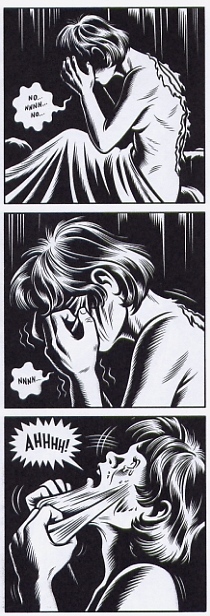 You might know Burns’s work from his advertisements or his illustrations for The Believer. But he’s best known as the writer and illustrator of the graphic novel, Black Hole, a compilation of his twelve-volume comic book. Burns worked on this over the course of ten years. And one of its remarkable qualities is the way that it remains remarkably consistent in its tone, despite the fact that Burns saw his two daughters grow up as he patiently put his work together. Black Hole depicts the story of a sexually transmitted disease that afflicts various teenagers in the Pacific Northwest. The work is very much a Rorschach test for the reader. One might infer a parable about AIDS or, if you wanted to get really reductive, innocence lost. Or it can be simply enjoyed as a dark tale of American adolescence gone awry.
You might know Burns’s work from his advertisements or his illustrations for The Believer. But he’s best known as the writer and illustrator of the graphic novel, Black Hole, a compilation of his twelve-volume comic book. Burns worked on this over the course of ten years. And one of its remarkable qualities is the way that it remains remarkably consistent in its tone, despite the fact that Burns saw his two daughters grow up as he patiently put his work together. Black Hole depicts the story of a sexually transmitted disease that afflicts various teenagers in the Pacific Northwest. The work is very much a Rorschach test for the reader. One might infer a parable about AIDS or, if you wanted to get really reductive, innocence lost. Or it can be simply enjoyed as a dark tale of American adolescence gone awry.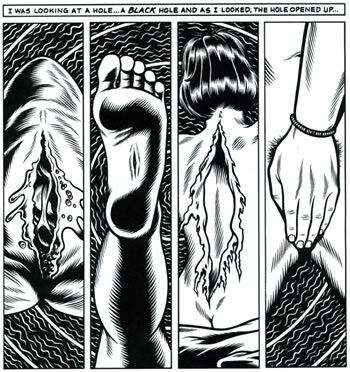 Correspondent: Okay. I also wanted to ask you about some of the anatomical close-ups throughout Black Hole. They remind me very much — in addition to the pustules and the various biological impediments that many of the characters have — it reminds me very much of the sort of World War II venereal disease films.
Correspondent: Okay. I also wanted to ask you about some of the anatomical close-ups throughout Black Hole. They remind me very much — in addition to the pustules and the various biological impediments that many of the characters have — it reminds me very much of the sort of World War II venereal disease films.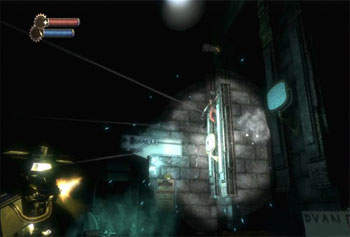 I can certainly agree with Ebert that video games are, for the most part, showcases for the latest gaming engines, primarily designed so that the individual will drop hundreds of dollars for a next-generation console system or a needlessly expensive video card that will be outdated in a few years (only to be replaced by yet another). We are now in the nickelodeon days, although, as the Wii demonstrates, the game controllers are getting more interesting. But this multi-billion dollar industry is less concerned with the human experience than it should be. It has come close with
I can certainly agree with Ebert that video games are, for the most part, showcases for the latest gaming engines, primarily designed so that the individual will drop hundreds of dollars for a next-generation console system or a needlessly expensive video card that will be outdated in a few years (only to be replaced by yet another). We are now in the nickelodeon days, although, as the Wii demonstrates, the game controllers are getting more interesting. But this multi-billion dollar industry is less concerned with the human experience than it should be. It has come close with  Replace “motion pictures” with “video games” and you essentially have what’s
Replace “motion pictures” with “video games” and you essentially have what’s 

 The reports promised snow but prevaricated. My mind marinated. You get that feeling when you are conned into picking away at a slice of red velvet cake because it’s there and you have only poor penmanship instead of an able fork. Never mind culinary sullies. The owl’s snooty hoots belied a ballistic solipsism suggesting the sword was mightier than any midnight rambler. And we were rendered into spittle and drivel hoping that flurry would scurry and leave us with some natural marching power.
The reports promised snow but prevaricated. My mind marinated. You get that feeling when you are conned into picking away at a slice of red velvet cake because it’s there and you have only poor penmanship instead of an able fork. Never mind culinary sullies. The owl’s snooty hoots belied a ballistic solipsism suggesting the sword was mightier than any midnight rambler. And we were rendered into spittle and drivel hoping that flurry would scurry and leave us with some natural marching power.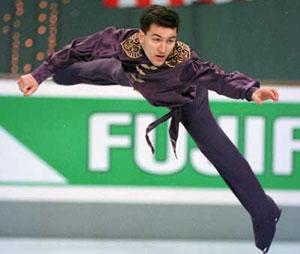 The first time I saw a quadruple jump performed live, I was barely a mile from the house I grew up in. It was December 1995.
The first time I saw a quadruple jump performed live, I was barely a mile from the house I grew up in. It was December 1995. 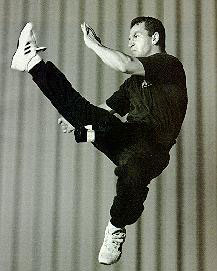 Any doubts about Stojko’s fitness and quad mastery dissipated in practice. Where before I required a working television to count the setup’s 1-2-3, with the edge change and toe pick deep into the ice just before Stojko pulled his body together for four tightly wound revolutions, leaving me a half second to wonder if he would, in fact, land the jump cleanly on one foot, now I could do so in person. He whipped out quad after quad, sometimes in combination, during the practice sessions. The fans, far fewer than the numbers attending Nationals and later the World Championships in Edmonton, responded with the fervor and noise of a crowd twice its size. Stojko was relaxed, jocular, keeping up a perpetual professional equally adept with wide-eyed kids, sycophantic adults, and me — a teenager trying hard to be too cool for school and failing.
Any doubts about Stojko’s fitness and quad mastery dissipated in practice. Where before I required a working television to count the setup’s 1-2-3, with the edge change and toe pick deep into the ice just before Stojko pulled his body together for four tightly wound revolutions, leaving me a half second to wonder if he would, in fact, land the jump cleanly on one foot, now I could do so in person. He whipped out quad after quad, sometimes in combination, during the practice sessions. The fans, far fewer than the numbers attending Nationals and later the World Championships in Edmonton, responded with the fervor and noise of a crowd twice its size. Stojko was relaxed, jocular, keeping up a perpetual professional equally adept with wide-eyed kids, sycophantic adults, and me — a teenager trying hard to be too cool for school and failing. 
 Lorrie Moore’s
Lorrie Moore’s  I wonder if Moore remains aware that,
I wonder if Moore remains aware that,  Why don’t you just get a blog?
Why don’t you just get a blog? Like many statues nestled along the rectangular trestles of Manhattan’s parks, Karl Bitter’s bronze depiction of Carl Schurz — situated at the corner of Morningside Drive and 116th Street — is regularly overlooked by many New Yorkers. They walk their dogs. They chat on their cell phones. They rush to important appointments or set out to beat a jogging record. But they rarely stop to observe this rather tall and intriguing figure who remains memorialized.
Like many statues nestled along the rectangular trestles of Manhattan’s parks, Karl Bitter’s bronze depiction of Carl Schurz — situated at the corner of Morningside Drive and 116th Street — is regularly overlooked by many New Yorkers. They walk their dogs. They chat on their cell phones. They rush to important appointments or set out to beat a jogging record. But they rarely stop to observe this rather tall and intriguing figure who remains memorialized.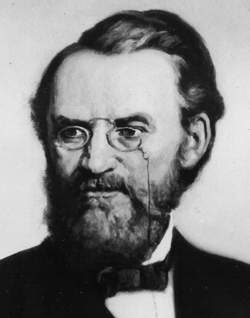 Schurz spoke these words as two friends of his were the top mayoral candidates. He would not let friendships get in the way of principle. Likewise, he did not think much of William Jennings Bryan and also campaigned against him.
Schurz spoke these words as two friends of his were the top mayoral candidates. He would not let friendships get in the way of principle. Likewise, he did not think much of William Jennings Bryan and also campaigned against him.
 I lean into my computer screen chin on fist, eyes leveled. Before me, a woman lies face down on an unremarkable bed. A man moves the woman’s hands behind her back. The woman waits patiently as he ties her hands together securely but comfortably with a simple rope. His wedding ring gleams as he pushes up her cotton frock and takes his time easing her panties down over her thighs. For the next several minutes, he fondles her. His caresses move from the swells of her buttocks to the folds of her genitals. She undulates and rears up against his hands. His fingers disappear inside her. She exhales pure desire in this otherwise quiet scene. At one point the man clutches the woman’s hand in a silent, tender communication. Then he reaches for something off screen. Shuffling noises ensue. A twisted tube of lubricant and vibrator appear. The play becomes more aggressive, as do the woman’s reactions. She strains to open her legs against the binding panties around her knees and another rope around her ankles.
I lean into my computer screen chin on fist, eyes leveled. Before me, a woman lies face down on an unremarkable bed. A man moves the woman’s hands behind her back. The woman waits patiently as he ties her hands together securely but comfortably with a simple rope. His wedding ring gleams as he pushes up her cotton frock and takes his time easing her panties down over her thighs. For the next several minutes, he fondles her. His caresses move from the swells of her buttocks to the folds of her genitals. She undulates and rears up against his hands. His fingers disappear inside her. She exhales pure desire in this otherwise quiet scene. At one point the man clutches the woman’s hand in a silent, tender communication. Then he reaches for something off screen. Shuffling noises ensue. A twisted tube of lubricant and vibrator appear. The play becomes more aggressive, as do the woman’s reactions. She strains to open her legs against the binding panties around her knees and another rope around her ankles.  People often assume that women dislike pornography or that they don’t like it as much as men. That’s an oversimplification. I want to like porn. But professional videos are less concerned with what feels good for a woman and more hard pressed on what is visually arousing for men — fellatio for instance. I’m not knocking it. It’s a wonderful erotic act that men love to watch, but that only gets me so far. On the flip side, pro porn constantly depicts cunnilingus as if it were a lollipop-licking contest with a misplaced emphasis on the visual. I always roll my eyes at that and think: Too bad. If he were doing it right most of the pink stuff wouldn’t be viewable.
People often assume that women dislike pornography or that they don’t like it as much as men. That’s an oversimplification. I want to like porn. But professional videos are less concerned with what feels good for a woman and more hard pressed on what is visually arousing for men — fellatio for instance. I’m not knocking it. It’s a wonderful erotic act that men love to watch, but that only gets me so far. On the flip side, pro porn constantly depicts cunnilingus as if it were a lollipop-licking contest with a misplaced emphasis on the visual. I always roll my eyes at that and think: Too bad. If he were doing it right most of the pink stuff wouldn’t be viewable.  The initial orgy was a blast. The woman sashaying nude down a busy street with a cigarette in one hand and a swinging purse in the other was so funny that I posted the clip on my blog and titled the entry “Confidence.” I assigned pithy quips to my discoveries and emailed the links. I asked, “Got vichyssoise?” of a huge leek being used as a dildo. “Her lips are sealed” was my commentary on the woman matter-of-factly tying her labia into a knot. These weren’t about arousal, but fun. If the people posting them were doing it to bolster their self-esteems, judging by the hit counts, they had to puff up like peacocks. I might have watched on with bewilderment, but why shouldn’t Super KnotGirl be proud of herself?
The initial orgy was a blast. The woman sashaying nude down a busy street with a cigarette in one hand and a swinging purse in the other was so funny that I posted the clip on my blog and titled the entry “Confidence.” I assigned pithy quips to my discoveries and emailed the links. I asked, “Got vichyssoise?” of a huge leek being used as a dildo. “Her lips are sealed” was my commentary on the woman matter-of-factly tying her labia into a knot. These weren’t about arousal, but fun. If the people posting them were doing it to bolster their self-esteems, judging by the hit counts, they had to puff up like peacocks. I might have watched on with bewilderment, but why shouldn’t Super KnotGirl be proud of herself? Correspondent: I’m wondering also about the Terri Schiavo narrative, because it does play in more later in the book than in the beginning of the book. Did you know immediately that there was this almost quasi-allegorical feel to that? Or did it start with the fact that you had Martin Miller in this coma?
Correspondent: I’m wondering also about the Terri Schiavo narrative, because it does play in more later in the book than in the beginning of the book. Did you know immediately that there was this almost quasi-allegorical feel to that? Or did it start with the fact that you had Martin Miller in this coma? Correspondent: Okay, well, if Davis and the donut girls was one of the key starting points, was this an imagined experience? Or was this drawn from anything specific that you observed? Because I am certainly not familiar with this phenomenon. (laughs)
Correspondent: Okay, well, if Davis and the donut girls was one of the key starting points, was this an imagined experience? Or was this drawn from anything specific that you observed? Because I am certainly not familiar with this phenomenon. (laughs) Correspondent: Going back to this issue of topography as a launching point, it’s reminiscent to me of Nabokov’s rule, where he basically said that he could not write a novel until he actually had a particular location. Likewise, in addition to this inspirational momentum, I wanted to first of all find out if this was a factor for you in terms of writing this. And it also leads into another question about Jarvis’s perspective, where she’s generally taking a small item and putting it into a larger neighborhood. For example, there’s a pack of cigarettes she observes. And she’s very clear in the way that she describes it as coming from a particular deli and how it was actually purchased and the like. So I wanted to ask you about this phenomenon. Was this a way for you to generate momentum in your book? You needed to get the lay of the land before the lay of the characters?
Correspondent: Going back to this issue of topography as a launching point, it’s reminiscent to me of Nabokov’s rule, where he basically said that he could not write a novel until he actually had a particular location. Likewise, in addition to this inspirational momentum, I wanted to first of all find out if this was a factor for you in terms of writing this. And it also leads into another question about Jarvis’s perspective, where she’s generally taking a small item and putting it into a larger neighborhood. For example, there’s a pack of cigarettes she observes. And she’s very clear in the way that she describes it as coming from a particular deli and how it was actually purchased and the like. So I wanted to ask you about this phenomenon. Was this a way for you to generate momentum in your book? You needed to get the lay of the land before the lay of the characters? I’m fine with the appreciation and education of American history. I’m not so fine on politicians seeing deities and religious influence in every corner and demanding that the country be “educated” about it. In examining Forbes’s endless “Whereases,” I’ve found more than a few historical humdingers and at least one egregious prevarication.
I’m fine with the appreciation and education of American history. I’m not so fine on politicians seeing deities and religious influence in every corner and demanding that the country be “educated” about it. In examining Forbes’s endless “Whereases,” I’ve found more than a few historical humdingers and at least one egregious prevarication.  The bullshit actually comes from Forbes, who puts phrases into Rev. Allison’s mouth that, as we can see and unless I can be proven wrong, simply don’t exist on the official record available to the public. Allison got Congress to move the Bibles not because Congress “desired to have a Bible printed under their care & by their encouragement,” but because, as the record states:
The bullshit actually comes from Forbes, who puts phrases into Rev. Allison’s mouth that, as we can see and unless I can be proven wrong, simply don’t exist on the official record available to the public. Allison got Congress to move the Bibles not because Congress “desired to have a Bible printed under their care & by their encouragement,” but because, as the record states:
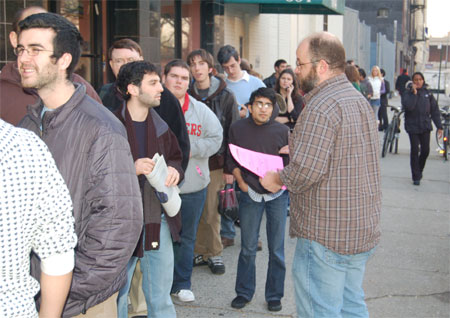





 Days before at a French bistro, there had been an elliptical receptacle of fries (or, to be specific, pommes frites, lightly seasoned with salt and fresh parsley). A bonus. An unanticipated side dish, really. We masticated on ten out of the perhaps ninety thin rectangular wedges jutting upward like baked and irregular flowers. But the waiter had not waited to take them away. Indeed, he had not given us the choice of picking away at more fries or a moment of silence in which we could grant them the eulogies they clearly deserved. Perhaps he wanted this table cleared so that another set of customers could use it.
Days before at a French bistro, there had been an elliptical receptacle of fries (or, to be specific, pommes frites, lightly seasoned with salt and fresh parsley). A bonus. An unanticipated side dish, really. We masticated on ten out of the perhaps ninety thin rectangular wedges jutting upward like baked and irregular flowers. But the waiter had not waited to take them away. Indeed, he had not given us the choice of picking away at more fries or a moment of silence in which we could grant them the eulogies they clearly deserved. Perhaps he wanted this table cleared so that another set of customers could use it.  What you will find here are long-form entries on a wide range of topics: some involving strange journalism, some involving cultural commentary, some involving personal experience, and some involving bizarre satirical exercises. Eventually, the plan here is to offer one new story each day, five days a week. I’ll still be appearing here on a regular basis, writing at least two to three posts a week (and considerably more during the opening weeks). But the difference this time is that this website will also be a place for other writers to offer unusual and idiosyncratic perspectives. This is a place that will retain its whimsical iconoclasm, but the new emphasis involves a more thoughtful approach. We also have editors on board, all kind enough to volunteer their time, who will be helping to shape the pieces that will appear here.
What you will find here are long-form entries on a wide range of topics: some involving strange journalism, some involving cultural commentary, some involving personal experience, and some involving bizarre satirical exercises. Eventually, the plan here is to offer one new story each day, five days a week. I’ll still be appearing here on a regular basis, writing at least two to three posts a week (and considerably more during the opening weeks). But the difference this time is that this website will also be a place for other writers to offer unusual and idiosyncratic perspectives. This is a place that will retain its whimsical iconoclasm, but the new emphasis involves a more thoughtful approach. We also have editors on board, all kind enough to volunteer their time, who will be helping to shape the pieces that will appear here.